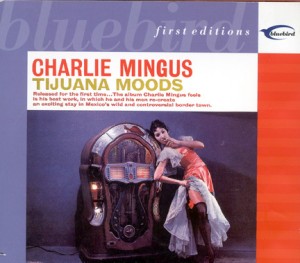Review: Charlie Mingus – Tijuana Moods
Bluebird Re-Issue Series
©Laurence Svirchev
 The back cover of Tijuana Moods, recorded in 1957 but released in 1962, boldly proclaims Mingus saying, “This is the best record I ever made.” Each re-issue has retained the quote, but alternate arguments could be made that the words were either Mingus bombast, or a promotional scheme of an artist whose band-members and performance-repertoire had radically changed since the recording was made. In the gap between the recording and issuing of Tijuana Moods, the brilliant MingusAh Um and Mingus Dynasty were issued on CBS. Irrespective of Mingus’ opinion, one could not say that these were less spectacular music than Tijuana Moods (see my review in Planet Jazz, Fall/Winter 1999).
The back cover of Tijuana Moods, recorded in 1957 but released in 1962, boldly proclaims Mingus saying, “This is the best record I ever made.” Each re-issue has retained the quote, but alternate arguments could be made that the words were either Mingus bombast, or a promotional scheme of an artist whose band-members and performance-repertoire had radically changed since the recording was made. In the gap between the recording and issuing of Tijuana Moods, the brilliant MingusAh Um and Mingus Dynasty were issued on CBS. Irrespective of Mingus’ opinion, one could not say that these were less spectacular music than Tijuana Moods (see my review in Planet Jazz, Fall/Winter 1999).
Rather than concentrate on which album was “best”, it is perhaps more constructive to state that the artistic output of Mingus was consistently at the highest level. Mingus’ compositional sense never repeated itself as the years went on; when he performed the work of other composers, he had the knack of breathing inspiration into them. On this album “Dizzy Moods” is a re-working of the Dizzy Gillespie classic “Woody ‘n’ You”, although the only way you can tell this is that Mingus states it is so in his liner notes. He only hired the most expressive musicians, continually pushing and even bullying them to outdo themselves. On this album there are two exceptional musicians who never made it into the “famous roster” of the jazz world: Clarence Shaw (trumpet) and Bill Triglia (piano) in addition to the better known Jimmy Knepper (trombone), Shafi Hadi (alto sax), and Danny Richmond (drums).
The music is related to a crisis in Mingus’ life when he and Richmond debauched themselves in Tijuana, Mexico. The music, however, does not contain the breath of next-morning tequila or other indelicacies. Quite the contrary, it is celebratory and uplifting.
The most complex and exciting composition of the CD is “Ysabel’s Table Dance.” It opens with castanets and Mingus exhibiting his extraordinary bass chops, playing the bass line pizzicato and rapidly alternating this technique with flamenco-style strumming of his finger-nails across the strings. Then he switches to playing arco in the cello range. I’m going to speculate that Mingus had a double bass and a cello in the studio and interchanged them while recording. Mingus often used his own voice to deliver shouts and hollers exhorting the musicians, but on this track he uses the female voice of flamenco dancer Ysabel Morel to exclaim the crie de coeur.
“Ysabel’s Table Dance” is notable for several compositional devices. Mingus contrasts the Spanish mode of music with the jazz feel of the late 1950s: this can be heard in Hadi’s solo at the beginning of the piece. There are multiple tempo and rhythm shifts which keep the music dynamic. Mingus was an ace trickster: these shifts are effortless, natural, and you don’t feel them coming or even as they are happening. You only notice them in aural retrospective. Thirdly, Mingus use three horns simultaneously singing different lines permit a wide variety of solo and group improvisations. This last device was a trademark of New Orleans style improvisation, but it was also a preview of the developments of free jazz in the 1960s. Mingus was based in the tradition of jazz, but he was also one of its prophets.
The original music for Tijuana Moods totaled thirty-six minutes. This re-issue is spread over two CDs. It turns out that Mingus and the production group used a significant amount of time splicing various takes of the music into a final album. This double CD contains almost all of the variations, including some complete alternate takes, making the reissue a history lesson in pre-digital editing techniques. The music was superbly recorded, and in the master-takes the splices are not obvious unless a listener deliberately goes listening for them. But such a search defeats the purpose of digging this amazing music, doesn’t it?
So what is the value in this particular re-issue? Unless one has a fascination for recording techniques or a scholarly interest in the music, the second CD with session footage is non-essential. The value is in the first five tracks: exciting compositions, fantastic bass work, and the trumpet virtuosity of Clarence Shaw. In re-printed liner notes, Mingus dwells on Shaw’s musicianship and explains how he searched for the man to get him back in the band. Perhaps his statement “This is the best record I ever made” was really a nod to nostalgia, a time he could no longer re-create.
Originally published in Planet Jazz, Montreal, 2003